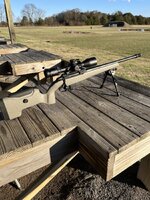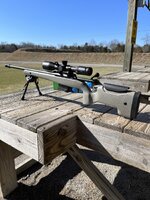That’s a pretty good list. Answers below will be for the 5-95% of people. Generally if you aren’t below 5 foot, or above 6’5” that’s you.
I am speaking to observed function in hundreds of shooters/hunters and tens of thousands of rounds fired in the mountains and deserts for all position field shooting- I.E., hunting animals from Florida to Alaska; not PRS, barricade benchrest, or F-Class.
Considerations:
- Rigidity/Accuracy
- Bedding required vs not
- Proclivity for shift to occur
All things being equal, and aluminum or magnesium mini chassis is probably best for bedding and stability.
- Ergonomics
- Grip
- Hand position
- Access to bolt and safety
- Access to magazine
- Head position
- Recoil management
- Length of pull
- Grip should be near vertical, thinner rather than large, and a small palm swell does well for most. Distance from trigger face to grip face should be shorter than most stocks feature.
- hand position should be near vertical, with the tang being rounded and/or scalloped for the firing side thumb to line up neutrally.
- access to bolt and safety, true vertical grip, not a pistol grip. Thumb neutrally inline with tang; not PRS offside, or totally wrapped around.
- Access ti magazine. Magazine release should be unobtrusive, and not susceptible to inadvertent release.
- Head position. Not sure what you mean here? Angle of the head/face? If so, not totally vertical, and not totally parallel.
- Recoil management. Straight line, neutral.
-Length of pull. That is based on each person, however the trend to shooting short LOP’s doesn’t seem to be great across the board. It’s great in prone, or a perfect tripod position, but in alternate field positions it seems to be causing more issues than a slightly too long LOP. FWIW, I shoot a longer LOP than would be suggested.
- Field Position Shooting
- Interface with rear support
- Interface with front support
- Other considerations for adverse conditions/odd spots
- Interface with rear support. Toe line should be parallel, or near parallel with bore. Bag.
- Interface with front support. Forend should be parallel with bore. Rounded for carry comfort, and ability to wedge/lock in on odd supports. Should bot be overly wide. Nothing should be hanging from the bottom of the forend unless currently using that item- I.E., no pic rails, Arca, etc. They suck when shooting from odd positions and only hurt the shooter when not utilizing them. If required to have a rail, having a short rail mounted all the way to the front, or all the way to the rear (sucks when carrying) has the least interference when shooting.
- Weight
- Minimum weight
- Option to add weight(truck hunts, load development, etc)
- Minimum weight without sacrificing stability. Currently that seems to be between 20-30 ounces.
- Adding weight is a game thing. Waking up on day and being like “I’m going to add four pounds to my rifle for this deer hunt this morning” is not a real thing. Either the gun is shootable or it isn’t.
- Other characteristics
- Folding to minimize packed OAL
- Use in cold weather
- Carrying-sling or other
- Magazine compatibility
- Folding would be great, unfortunately in conventional stocks it adds a lot of undue weight. Not a requirement generally.
- Cold weather. No metal. Metal chassis absolutely suck in the cold. I know two people that have gotten mild to sever skin tissue damage from carrying and shooting metal chassis in Montana. No can not overstate how much metal chassis suck in the cold.
- Sling use seems to be person specific. Almost no one I am around hunts with them on the rifle anymore.
- AICS is the standard. However, at least with Tikkas if the carriage fits in the factory mag, they are more reliable and better feeding than AICS.
A field stock should be composite or wood, not metal. Jesse for ideally with a magnesium mini chassis/bedding block. A near vertical grip, not pistol grip, that is rounded and scalloped to allow the thumb to be inline with the tang. Trigger reach should be relatively short. It should have a negative comb, and negative drop at heel (butt pad inline with barrel). The toe should be parallel with the bore, or at least have a usable flat spot. The forend should be parallel with the bore, of standard width, flatter on the bottom with rounded sides. A hidden or recessed way to quickly attach tripods or bipods, that does not interfere with the forend or carrying.
Of every stock on the market, this is as close as anyone has come to getting it all correct-
View attachment 577411


